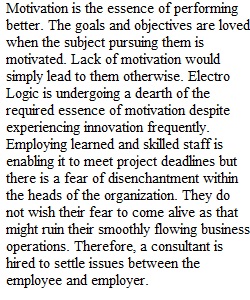


Q Case # 3: Electro Logic Case Involving Motivation Problems p. 288 10th edition Based on an actual organization, this case will give you experience using the chapter’s diagnostic models to identify motivation and performance problems. There are two main questions to include in the report. Task: You have been hired as a consultant by the owner to identify specific performance and motivation problems and recommend changes. The firm has expanded quickly, and the owner is concerned about rumors of growing disenchantment. Support your analysis with evidence from the case and make very specific recommendations for change. 1. Using the behavioral guidelines and Figure 6.10 Summary Model of Motivating Performance, as diagnostic aids, what are the strengths and weaknesses of Electro Logic from a motivational perspective? Behavioral Guidelines (from the textbook) The behavioral guidelines suitable for motivating performance are organized according to the major sections of this chapter. To aid in their implementation, illustrative diagnostic questions are included. Foster High Performance A. Strengthen the Motivation ? Performance Link Performance Expectations/Goals ? Establish clear, realistic performance expectations that are both understood and accepted. ? Formulate goals collaboratively, if possible. ? Establish goals that are specific, consistent, and challenging. ? Provide frequent, specific, and accurate feedback on performance. Ability ? Match assignments with individuals’ aptitude, based on their mastery of related tasks. ? Match assignments with individuals’ training, or make provisions for the required training. ? Make sure individuals have the organizational resources required to perform their assignments, such as technical information, financial support, personnel, and clearances to work with other units. ? Gear your level of involvement as a leader to how much help a person expects, your assessment of what is needed, and how much help is otherwise available. B. Strengthen the Performance ? Outcomes Link ? Use rewards to reinforce performance-enhancing behaviors and the accomplishment of specific performance goals. ? Use discipline to correct performance-distracting behavior and unacceptable levels of performance. ? Never assume that a nonresponse to unacceptable behavior will be interpreted by the actor as negative feedback. ? Administer rewards and discipline in a timely manner. ? Foster intrinsic motivation via management practices and job attributes that contribute to the fulfillment of employees’ needs for competence (mastery), autonomy, relatedness (social connection), and a sense of purpose. C. Strengthen the Outcomes ? Satisfaction Link ? Utilize rewards that individuals view as personally salient. ? Distribute rewards in ways that are perceived to be fair. Diagnose and Correct Unacceptable Performance A. Jointly investigate what caused the downturn in performance. ? Invite the employee’s explanation for their low performance rating. ? Use the E-A-M line of inquiry to nullify the harmful effects of the “universal attribution error.” ? Foster a problem-solving approach by seeking to understand the person’s perspective, including giving due consideration to their external attributions. ? Treat all attributions as hypotheses to be tested against relevant facts. B. Make corrections and plan for performance improvement. ? Utilize the practices set forth in the “Fostering Exceptional Performance” section, and the corresponding Behavioral Guidelines. Figure 6.10 Summary Model for Motivating Performance 2. What are the high-priority action items you would include in a consulting report to Steve Morgan, president of EL? Focus on specific actions he could initiate that would better use the abilities of the staff and foster a more motivating work environment. Additional Thoughts/Questions for Refection and Discussion: * Find examples of individuals motivated by different “outcomes.” * What are the implications of these different preferences for the management of this firm? * Using the path-goal model of leadership (shown in Figure 6.4: Leader Involvement and Subordinate Performance), how involved should Steve (EL President) be in facilitating goal accomplishment with the following groups of employees: research scientists, technical support, administrative support? Figure 6.4 Leader Involvement and Subordinate Performance Case Report Outline I. Introduction II. Strengths and weaknesses of Electro Logic from a motivational perspective III. Recommendations IV. Conclusion Running head: ASSIGNMENT: CASE STUDY REPORT #3
View Related Questions